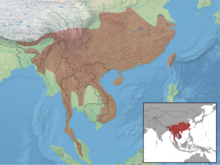Pallas's squirrel
| Pallas's squirrel | |
|---|---|

| |

| |
| Scientific classification | |
| Domain: | Eukaryota |
| Kingdom: | Animalia |
| Phylum: | Chordata |
| Class: | Mammalia |
| Order: | Rodentia |
| Family: | Sciuridae |
| Genus: | Callosciurus |
| Species: | C. erythraeus
|
| Binomial name | |
| Callosciurus erythraeus (Pallas, 1779)
| |
| Subspecies | |
|
About 30; see text | |

| |
| Synonyms | |
|
Callosciurus flavimanus | |
Pallas's squirrel (Callosciurus erythraeus), also known as the red-bellied tree squirrel, is a species of squirrel native to China, Taiwan, India, and Southeast Asia.
Description

Pallas's squirrel is a medium-sized tree squirrel, with a head-body length of 16 to 28 cm (6.3 to 11.0 in), and a tail 11 to 26 cm (4.3 to 10.2 in) in length. Both sexes are of similar size and appearance, and weigh between 310 and 460 g (11 and 16 oz). The colour of the pelt varies considerably between the many different subspecies, but is generally brownish on the upper body with a more reddish tint on the belly, and often with some black on the tail. The precise pattern and shades of the fur are often used to distinguish subspecies from one another, but make it difficult to distinguish the species as a whole from other, similarly variable, tree squirrel species.[2]
Subspecies
Over 30 subspecies have been identified, although not all are recognised by all authorities:[2]
|
|
|
|
Distribution and habitat
Pallas's squirrel is found throughout much of southeastern Asia, including far eastern
Populations have been introduced in the
Biology

Like all tree squirrels, Pallas's squirrels are primarily
The squirrels breed throughout the year, and may mate again as soon as they have weaned a previous litter. Gestation lasts 47 to 49 days, and results in the birth of up to four young, with two being typical. The young leave the nest at 40 to 50 days old, and are sexually mature at one year of age. They have lived for up to 17 years in captivity.[2]
Behaviour

Pallas's squirrels are diurnal,[2] and inhabit much of the forest canopy, and construct both leaf nests 7 to 18 m (23 to 59 ft) above the ground, and less commonly, in burrows.[8] Females occupy home ranges of just 0.5 to 0.8 hectares (1.2 to 2.0 acres), which usually do not overlap, while males occupy much larger ranges of 1.3 to 3.8 ha (3.2 to 9.4 acres), which overlap with those of both nearby males and females.[9] Like many other squirrels, they have been observed to cache acorns in the autumn.[3]
The squirrels make calls to warn neighbours of predators, and have been observed to mob tree-climbing snakes, with females protecting young being particularly likely to join in.[10] Males also make loud calls both prior to and after mating.[11]
References
- ^ . Retrieved 12 November 2021.
- ^ doi:10.1644/902.1.
- ^ .
- ^ Instituut voor Natuur- en Bosonderzoek
- ^ "List of Invasive Alien Species of Union concern - Environment - European Commission". ec.europa.eu. Retrieved 2021-07-26.
- ^ "REGULATION (EU) No 1143/2014 of the European parliament and of the council of 22 October 2014 on the prevention and management of the introduction and spread of invasive alien species".
- .
- JSTOR 1381991.
- JSTOR 1381382.
- S2CID 23763014.
- S2CID 32364496.

